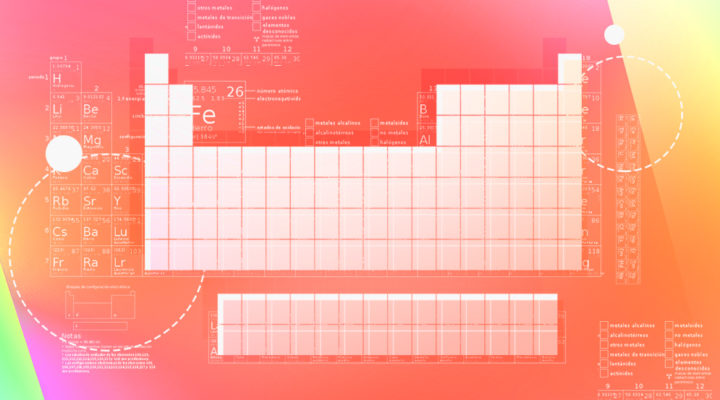SCIENCE & SOCIETY
2019, the International Year of the Periodic Table
CONICET scientists reflect on the importance of the UNESCO’s declaration.
In 1869, the Russian chemist Dmitri Mendeleev laid the foundation for the periodic table of elements formulating the periodic law: certain properties of the elements periodically reoccur in relation to their mass. A hundred and fifty years later, the United Nations General Assembly and UNESCO proclaimed 2019 the “International Year of the Periodic Table of Chemical Elements (IYPT2019)” to commemorate this essential event for science.
Just like quarter notes and quavers capture in sheet music the universal language of music, the periodic table of the elements portrays the shared language of sciences; a language that confines the essence not only of Chemistry, but also of Physics, Biology, Astronomy and other disciplines. This unique tool allows scientists to predict the appearance and properties of matter in the Earth and in the Universe.
Many institutions around the Globe, in more than 50 countries, have joined together to celebrate the 150th anniversary, such as the International Council for Science (ICSU), the International Union of Pure and Applied Physics (IUPAP) and the International Astronomical Union (IAU).
Celebrations are taking different forms to please all tastes: from story writing competitions with chemical elements as mains characters, to the creation of a 15-square-meter crochet periodic table (STOL – Science Through Our Lives, University of Minho).
In Argentina, professional and amateur astronomers are also enthusiastic about the initiative and are creating a collection of themed periodic tables –with video games heroes or musical genres, for example.
Also, many CONICET scientists have been inspired to express a reflection or feeling about this particular event: “The fact that 2019 have been proclaimed the International Year of the Periodic Table increases society’s interest about science,” expresses Dr. Manuela Kim, a specialist in Inorganic, Analytical and Physical Chemistry.
“The periodic table is a very useful tool for the teaching of Chemistry. It is an example of how we can use quantitative data without the necessity of having to memorize it,” says Silvia Porro who leads a research group on science teaching (GIECIEN- National University of Quilmes) and works as a CONICET scientific consultant for the Scientific and Technological Researcher Career (CIC).
Porro thinks that teachers could use the periodic table to explain the concept of periodicity and how the properties of the different atoms can be used as classification criteria. She also encourages using “the history of Chemistry to illustrate how scientific knowledge is created and to understand the nature of science, all contents that are essential for the citizenship scientific education,” she adds.
Dr. Leonardo Pellizza, independent researcher at CONICET and President of the Argentine Association for Astronomy, also gives his opinion: “This is a very special commemoration for astronomers because we study the origin of the chemical elements, that is, how they were created.”
“Nowadays, we know that the Universe began with a very condensed state of extreme high temperatures; it was formed by the elementary constituents of matter. When it cooled down, lighter chemical elements appeared like Hydrogen and helium, which are the most abundant elements in the Universe. This period is called ‘Big Bang nucleosynthesis’ and it occurred on the first seconds of life,” he explains.
All the other elements were formed in the interior of the stars through nuclear fusion: lighter elements are combined to form the heavier ones. Thus, Hydrogen and helium can formed other elements such as Carbon, Nitrogen, oxygen, Iron.
Female contributions to the table
The Year of the Periodic Table represents also “a great opportunity to assert the role of women scientists that made fundamental contributions to today’s periodic table,” considers Kim. “Women like Ida Noddack (1896–1979), co-discoverer of rhenium (Re), Marie Skłodowska Curie (1867-1934), co-discoverer of Polonium (Po) and Radium; Marguerite Perey (1909-1975) who discovered Francium (Fr), among other great scientists that, with their incredible talent, forged Chemistry and Physics as sciences, even in unfavorable social conditions.
This women-on-science’s blooming is so strong that an international symposium on women’s contribution to the periodic table took place in Murcia, Spain, last February; and Nature magazine has published some comments on the importance that women has had in the discovery of many chemical elements.
“It should be interesting to use this UN declaration to take the theme to schools and to the general public, –Dr. Pellizza summarizes– not only to teach about science, but also to show how science is related to people, to society”. And Dr. Kim adds: “What would be Chemistry like without the periodic table of the elements? It would be like a wordless book, or like Math without numbers… we would be lacking the ABC that allows us to speak one of the universal languages of science”.
By: Jorgelina Martínez Grau
